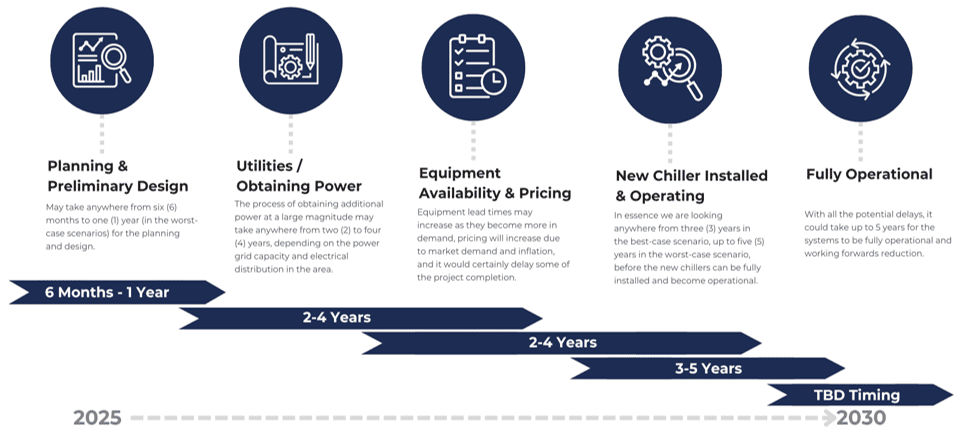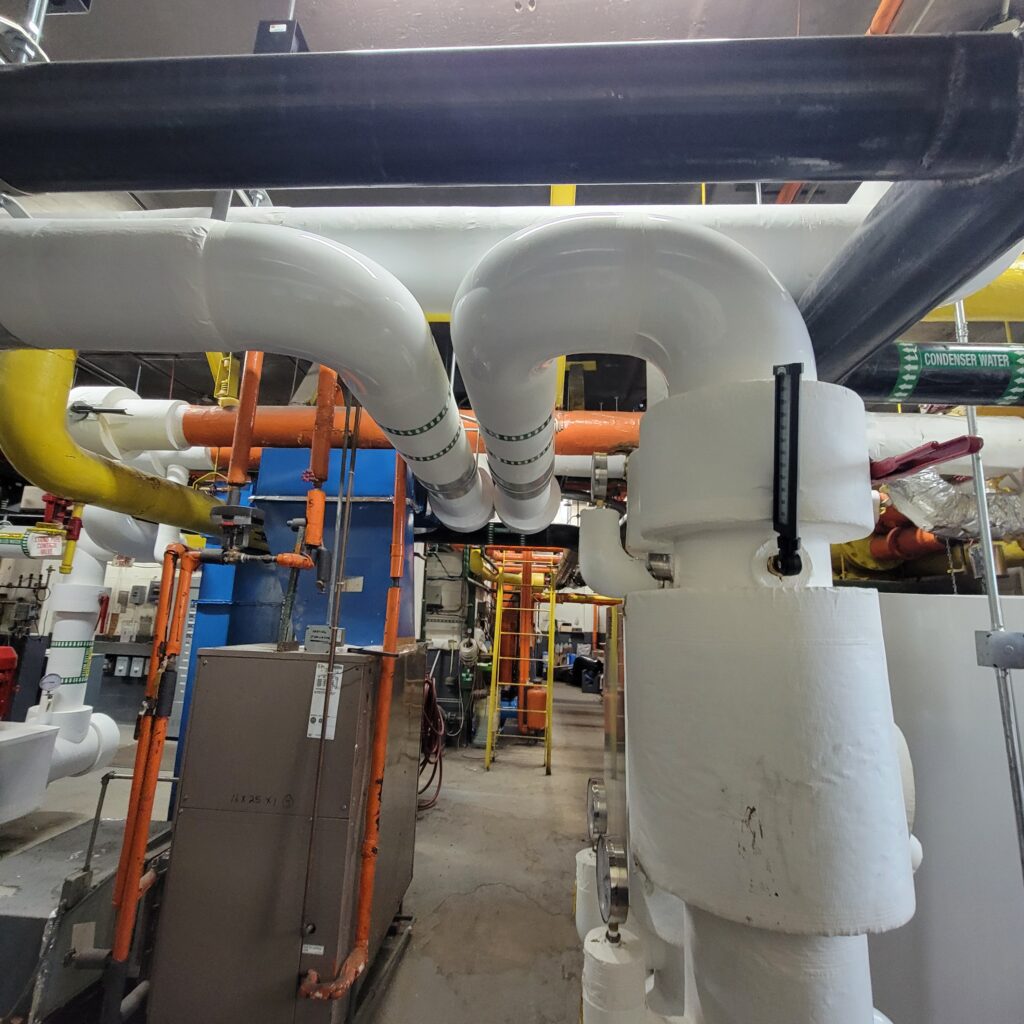Local Law 97 – Webinar Recap
December 12, 2024
Preparing for Local Law 97: A Recap of Our Fall 2024 Webinar
We recently hosted an informative webinar focused on New York City’s Local Law 97 (LL97), an important local law aimed at reducing greenhouse gas emissions from large buildings over 25,000 square feet. As the city moves toward carbon neutrality by 2050, building owners, developers, architects and engineers need to start planning now to ensure compliance with this landmark legislation. In case you missed it, here’s a recap of the webinar, including key takeaways, critical deadlines, and strategies for navigating the LL97 compliance landscape.
Webinar Overview
Our expert panel consisted of Nicholas Dalton, Director of MEP Engineering at HLZAE, Jon Colatrella, PE, CEM, CBCP, Executive Director of MEP & Forensic Engineering at HLZAE, and Jon Zelinsky, PE, Executive Vice President of Corporate Strategy at Milrose Consultants. Together, they provided practical guidance for understanding the timeline and steps needed to prepare for Local Law 97.

“The DOB is under a lot of pressure to implement Local Law 97. We advise all clients that Local Law 97 is here to stay, and it’s being bolstered by the actions the DOB is taking right now.”
– Jon Colatrella
Key Learning Objectives
1. Understanding Local Law 97 Timelines
The webinar kicked off by breaking down the key deadlines associated with LL97:
- January 1, 2024: Building carbon emissions will start being tracked.
- May 1, 2025: The first emissions report, covering 2024, must be certified by a registered design professional and filed with the NYC Department of Buildings (DOB).
- Future Compliance Intervals: Compliance becomes increasingly stringent every five years, with carbon neutrality goals set for 2050.
With the city’s increasing pressure to enforce deadlines, understanding and meeting these timelines is crucial for building owners to avoid penalties.
2. Planning for Delays

One of the most critical takeaways was the importance of planning ahead for potential delays. Meeting Local Law 97 compliance is a long-term process that can take several years, making early planning essential. The first step involves assessing your building’s energy use and creating a reduction plan, which can take six months to a year, depending on complexity.
“So what many may still not know right now is that if you own or manage a building that is subject to Local Law 97, you’re being evaluated as we speak.”
– Jon Colatrella
Many buildings also require utilities upgrades, which can take two to four years due to high demand in urban areas. Equipment delays are another common challenge, with the need for energy-efficient systems often leading to extended lead times and price fluctuations. Starting early allows you to secure necessary equipment before it’s needed.
Once equipment is in place, installation and commissioning can take an additional three to five years, requiring careful coordination to meet emissions reduction standards. Even after installation, ongoing adjustments may be needed to keep systems running efficiently.
By planning ahead, building owners can avoid delays and ensure compliance with Local Law 97’s deadlines, making it crucial to start the process early to stay on track.

3. Creating a Compliance Plan
Developing a comprehensive compliance plan was emphasized as a key component of successful LL97 compliance. This plan should outline the carbon reduction strategies your building will implement, including partnering with registered design professionals and addressing specific building needs. Proactive planning is essential to avoid last-minute scrambles that could lead to penalties.
“An experienced engineering firm will not only be able to ensure compliance reporting is completed but also provide a full Local Law 97 preparedness report to identify the most relevant carbon reduction measures for your building and outline the impact to your building implementing those measures.”
– Nicholas Dalton
4. Pathways to Compliance
There are various pathways to achieve compliance, and understanding these options will help you avoid unnecessary penalties. This includes verifying your building’s square footage with the DOB to ensure that your fines are based on accurate measurements.
“If your building is facing emissions that are over these allotted limits within the Local Law 97 legislation, there are opportunities to mitigate fines through good faith efforts. Given the complicated nature of going down this path, it’s important to put a plan in place to meet these various DOB requirements.”
– Nicholas Dalton
- Carbon Reduction Measures (Energy Efficiency & Fuel Switching) – This pathway involves making significant upgrades to building systems, such as improving energy efficiency through HVAC, lighting, or insulation improvements. Fuel switching, such as transitioning to renewable energy sources, can also help reduce emissions.
- Energy Efficiency Audits and Retro-Commissioning – Buildings can achieve compliance by conducting energy audits and retro-commissioning (retrofitting) existing systems. This process involves identifying inefficiencies in heating, cooling, and lighting systems and optimizing them for better performance.
- Emissions Offsets – For buildings that find it difficult to meet emissions reduction targets, purchasing emissions offsets is another option. These offsets help to balance a building’s emissions by supporting external projects that reduce or capture carbon, such as renewable energy or reforestation initiatives.
- Adjustments for Special Use Cases – Some buildings, like those operating 24/7, healthcare facilities, or non-profits, may qualify for special adjustments to their emissions limits due to their unique operational needs. This pathway allows for a more tailored approach to compliance.

Getting Started with HLZAE
Navigating Local Law 97’s compliance pathways can be complex, but HLZAE is here to guide you every step of the way. From assessing your building’s energy usage to implementing compliance strategies, our team has the expertise to help you meet the city’s emissions targets efficiently and cost-effectively.
Why Start Now?
While LL97 compliance might seem far off, waiting until the deadlines are close is a risky strategy. As highlighted during the session, early action is critical. Starting your preparations now can save significant time and money in the long run. The webinar presented an example project timeline, illustrating how much time it takes to complete necessary upgrades and achieve compliance. From planning and design (6 months to a year) to equipment installs (2-4 years), the entire process can take several years.
Additionally, the financial impact of waiting could be substantial. Fines for non-compliance include $0.50 per square foot per month for failure to file emissions reports and penalties for exceeding emissions limits. For example, a 25,000 sq ft building could face $12,500 in monthly fines if they don’t file on time.
Preparing Your Budget and Understanding Incentives
A major point of discussion was the importance of creating a realistic budget to account for all the necessary upgrades and regulatory compliance. The webinar emphasized that the cost of compliance will vary depending on your building’s needs, but with proper planning, you can take advantage of rebates, incentives, and financing options available to minimize the financial burden.
Building Upgrades and Retrofits
The panel also discussed various upgrades and retrofits that can help buildings reduce emissions. These include:
- Energy Efficiency Improvements: Upgrades to HVAC systems, heating and cooling plants, and lighting can significantly reduce emissions.
- Building Envelope Upgrades: Improving insulation, replacing windows, and upgrading roofs can make buildings more energy-efficient and reduce the load on mechanical systems, leading to lower emissions.
Additionally, investing in these upgrades now can prevent costly emergency replacements later. Larger systems, such as HVAC units or chillers, can be expensive to repair or replace when they break down, especially if they are outdated or inefficient. By proactively replacing aging systems and implementing energy-efficient solutions, you can avoid the rush to replace these systems under pressure, saving your company from high costs and downtime.
Local Law 97 Compliance Beyond 2024
While the first emissions report is due in 2025, the webinar pointed out that compliance will be an ongoing effort. Buildings will need to consistently monitor and upgrade their systems to meet increasingly stringent standards. The webinar also covered emerging rules and adjustments, such as the use of emissions offsets and changes to the fee structure for filing compliance reports, which will be released by the DOB in October 2024.

Conclusion
Local Law 97 is here to stay, and building owners and developers must begin preparing now. The window for planning is narrowing, and the risks of non-compliance are high. Start by evaluating your building’s current emissions, understanding the upgrade process, and partnering with experienced professionals who can guide you through the regulatory landscape. Remember, proactive planning today will save you from penalties and costly delays in the future.
For more resources and assistance with LL97 compliance, visit Milrose’s LL97 resource page.
Recommended Articles
Sorry, we couldn't find any posts. Please try a different search.